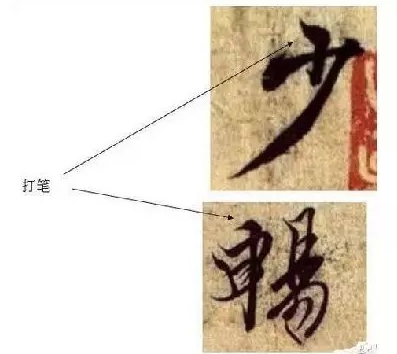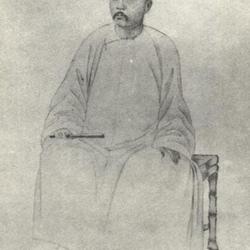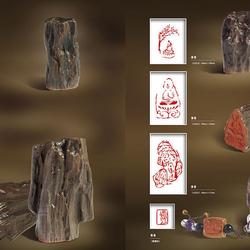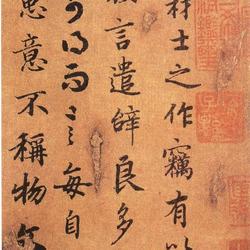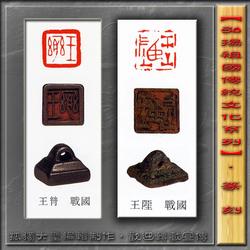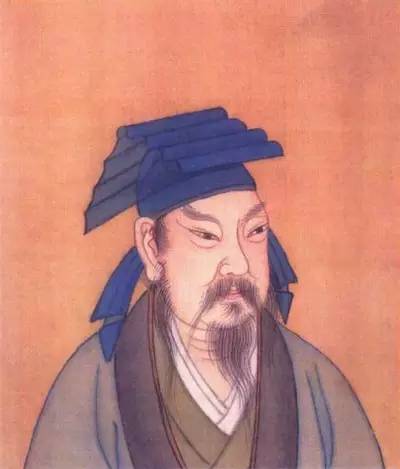
Wang Xizhi's "Twelve Chapters on Writing Style" and Preface
I tell you, Zijing: I have noticed that your writing skills are extraordinary, and you still do not follow the rules. It has been a tradition since ancient times that the father did not teach himself. Now I will describe one chapter of "The Theory of Writing Style" to enlighten you. There are still twelve chapters in Fansi's character style. Each chapter has its reference and its model. How can it be detailed? It's ridiculous, but it's important to summarize it and it's cheap to record it. There may be many variations, and it is difficult to get to the original; there may be many variations, and it is difficult to recognize the origin. The traces of hanging needles and dangling dew are difficult for the system; the momentum of making waves is enough to be charming. Therefore, identifying the cause can help cure the terminal illness. This book, "Le Yi Lun" and "Bi Shi Lun", are here to be kept for you and do not spread outside. They are kept secret and cannot be revealed to friends. If you study the seal script diligently, you can achieve it easily with little effort. If you compile it with precision and expertise, its shape and potential will be obvious. A scholar with a clear mind can see his merits in two months; a person without spirituality will know his roots in a hundred days. This writing and theory can be said to be a family treasure, learned and kept secret, and has a reputation in the world. I have been sharpening my pen for a long time, and with rare exceptions, I have finally succeeded in mastering it. I have studied it carefully, studied various rules, and saved its outline to formulate this theory. When I was first born, my classmate Zhang Boying wanted to meet him, but I lost my deceitful cloud. It was because I was so secretive that I refused to pass it on.
Chapter 1 of Chuanglin
If the husband is low, the formation is also, the author's sword? Also, ink is the armor of soldiers, water research is the city, skill is the general, mind is the deputy general, structure is the strategy,? The author's good and bad fortunes are also related to those who enter and give orders. Inflection means killing, dot painting means uprightness, Ge Zhi means chopping, indulgence means quickness, the author harmonizes, and cornering means frowning. When starting to write, do not use the full form. One time is to straighten the hands and feet, the second time is to get less form, the third time is slightly like the original, the fourth time is to add smoothness, and the fifth time is to add both extraction and extraction. If it is raw and astringent, it cannot be rested, it has two or three lines, and it must be smooth and healthy before it is hit, so it is not possible to count the number of times.
Chapter 2 of Enlightenment
If you want to learn the method of calligraphy, you should first grind the ink dryly, concentrate on it, and imagine the size of the characters, the shape of the characters, the shape of the characters, the straightness and vibration, then the muscles and veins will be connected, and the intention will be in front of the pen, and then write the characters. If it is straight and similar, shaped like an operator, with the top and bottom straight, and the front and back even, this is not a book, but it has its stippling. Yi of the former Song Dynasty (who was a disciple of Zhong Yao). After trying to write this book, Yao scolded him, so he didn't dare to see Yao for three years, so he devoted himself to correcting it. Every time a wave is made, there are often three folds; every time a stroke is made, the front is often hidden; every horizontal stroke is like a row of clouds in an array; every strike is like a hundred jun crossbows; every point is made , like a falling stone from a dangerous peak; □□□□, bent like a steel hook; every pull made, like a long-lived withered vine; every indulgence made, like the suddenness of a footstep, falling like a startled snake through the water, stirring up the waves of Chu. Written. It's like a dragon's meandering, which is said to be wonderful; if it's like a luan and a phoenix, it's said to be brave. The movements are like thunder and lightning. This is the secret of flying in the air. It floats and sinks in an instant, capturing the sonorous and inspiring thoughts. It can make people who are in a coma gradually feel satisfied; people who are knowledgeable can become obviously cheerful.
Visual Chapter 3
Looking at the body, the changes are still the same, looking at the appearance according to the situation, the high and low are interesting. Divide the stipples evenly, match the distance and the near; broadcast and refine, and harmonize the brush and ink. The front fibers are coming and going, dense and dense, the iron points are silver hooks, and the squares and circles are neat. When I start writing, I ponder and ponder, and explain the reasons, which will be passed down to the present and the ancients forever. A wise man is proud of himself and benefits the world, and his heart is deeply infiltrated; a fool does not wait for a good talk, like a brocade in the dark dust. Those who are born knowing become angry; those who learn and understand forget their meals. This is the best among the best, the new among the new. Jin Shu Jin Zi, ability comes first, safety is the main concern, and stability is the first priority. The partitions are white, and the top and bottom are flush, and the structure is uniform, especially the size. Large characters value small characters, and small characters value width. Naturally, width and narrowness can be used without losing their appropriateness. When it is horizontal, it is upright, like a lonely boat crossing the river; when it is vertical, it is straight, like spring bamboo shoots in a cold valley.
Say something Chapter 4
The spots are all like the channel of a big stone, or like a crouching owl, or like a bucket, or like a melon petal, or like a chestnut, with the mouth like an owl's mouth, and the tip is like rat excrement. Like this, everyone has his own way, but if he gets a little or a lot, the scholar will be enlightened.
Chapter Five of Chu Ge
The way the husband cuts the sword, the pole falls high and high, like a loose pine tree leaning against a stream valley, as if it is about to fall, and it is also like a hundred-jun crossbow at the beginning. Given his aggressive intentions, it’s hard to come up with wonderful ideas. It is released like a bow and an arrow, and closed like a tiger fighting and a leaping dragon. It is straight like a strong pine tree near the valley, and curved like a hanging hook fishing for water. Ling? It was cut in Yunhan and fell on the cliff. The sky gate rises and the earth and the households jump, the four seas are quiet but the five mountains are sealed; the jade candles are bright but the sun and the moon are obscured, the embroidery colors are chaotic and the brocade patterns are turned over.
Robust Chapter Six
The husband uses the method of bending his feet, bending like a horned bow, [bird], [yan], [wei], [crow] and the like. The way to establish a person is like a bird on the head of a pillar, [彳], [任], and the like. The method of the wrists and feet is like a strong man bending his arms, and the examples of [Feng], [Fei], [Fan], and [Qi] are the same. Urgent pulling and pulling is like lightning in the clouds. This is the example of [sun], [moon], [eye], and [cause]. The wrists and feet push up and down? The transition from beginning to end, all order and rhyme, don't make a wasp's waist and a crane's knees. It is better to conserve your energy when indulgence, and take advantage of the momentum by looking at the pen. The outline falls during the movement, like a warrior stretching out his hook, just facing the enemy, unicorns fighting horns, tigers gathering dragon's teeth, muscles and joints holding fists, brave body and strong body. If the method is used like this, the calligraphy progress will have merit. The traction is profound and wonderful, bright in the present, activating the spirit, raising the will, picking and thinking, the secret cannot be passed on. The husband folds the corner on the right side, quickly pulls it down and opens it slightly, and bends the left side, so that it can be taken up and faced, so as not to hurt the waist slowly. Look at the pen to take the momentum, go straight down, the interesting meaning is always there, and everyone is awakened.
Enlightenment Chapter 7
The drawing method of any character should not be reversed to the left or right side. The right side should be thicker than the left side. The horizontal side should be thinner and the vertical side should be thicker. The partitions are white, and the distance should be balanced, so that the top and bottom can be accommodated, and it will be naturally stable. When it is necessary to cover up each other, the shape and the edge of the teeth should not be exposed. Wherever the brush is turned, it should be observed and used.
Observation of Forms Chapter 8
夫临文用笔之法,复有数势,并悉不同。或有藏锋者大,藏锋在于腹内而起。侧笔者乏,亦不宜抽细而且紧。押笔者入,从腹起而押之。又云:利道而牵,押即合也。结笔者撮,渐次相就,必始然矣。参乎妙理,察其径趣。憩笔者俟失,憩笔之势,视其长短,俟失,右脚须欠也。息笔者逼逐,息止之势向上,久久而紧抽也。蹙笔者将,蹙,即捺角也;将,谓劣尽也。缓下笔,要得所,不宜长宜短也。战笔者合,战,阵也;合,叶也。缓不宜长及短也。厥笔者成机,促抽上勿使伤长。厥,谓其美也,视形势成机,是临事而成最妙处。带笔者尽,细抽勿赊也。带是回转走入之类,装束身体,字含鲜洁,起下笔之势,法有轻重也。尽为其著而后反笔抽之。翻笔者先然,翻转笔势,急而疾也,亦不宜长腰短项。叠笔者时劣,缓不宜垂。起笔者不下,于腹内举,勿使露笔,起止取势,令不失节。打笔者广度。打广而就狭,广谓快健,又不宜迟及修补也。
开要章第九
夫作字之势,饬甚为难,锋?来去之则,反复还往之法,在乎精熟寻察,然后下笔。作ノ字不宜迟,乀不宜缓,而脚尖不宜赊,腹不宜促,又不宜斜角,不宜峻,不用作其棱角。二字合体,并不宜阔,重不宜长,单不宜小,复不宜大,密胜乎疏,短胜乎长。
节制章第十
夫学书作字之体,须遵正法。字之形势不得上宽下窄;如是则是头轻尾重,不相胜任。不宜伤密,密则似疴瘵缠身;不舒展也,复不宜伤疏,疏则似溺水之禽;诸处伤慢。不宜伤长,长则似死蛇挂树;腰枝无力。不宜伤短,短则似踏死蛤蟆。言其阔也。此乃大忌,可不慎欤!
察论章第十一
临书安贴之方,至妙无穷。或有回鸾返鹊之饰,变体则于行中;或有生成临谷之戈,放龙笺于纸上。彻笔则峰烟云起,如万剑之相成;落纸则碑盾施张,蹙踏江波之锦。若不端严手指,无以表记心灵,吾务斯道,废寝忘餐,悬历岁年,乃今稍称矣。
譬成章第十二
凡学书之道,有多种焉。初业书要类乎本,缓笔定其形势,忙则失其规矩。若拟目前要急之用,厥理难成,但取形质快健,手腕轻便,方圆大小各不相犯。莫以字小易,而忙行笔势;莫以字大难,而慢展毫头。如是则筋骨不等,生死相混。倘一点失所,若美人之病一目;一国失节,如壮士之折一肱。予《乐毅论》一本,书为家宝,学此得成,自外咸就,勿以难学而自惰焉。
我们主要讲下——观形章
夫临文用笔之法,复有数势,并悉不同。或有藏锋者大,藏锋在于腹内而起。侧笔者乏,亦不宜抽细而且紧。押笔者入,从腹起而押之。又云:利道而牵,押即合也。结笔者撮,渐次相就,必始然矣。参乎妙理,察其径趣。憩笔者俟失,憩笔之势,视其长短,俟失,右脚须欠也。息笔者逼逐,息止之势向上,久久而紧抽也。蹙笔者将,蹙,即捺角也;将,谓劣尽也。缓下笔,要得所,不宜长宜短也。战笔者合,战,阵也;合,叶也。缓不宜长及短也。厥笔者成机,促抽上勿使伤长。厥,谓其美也,视形势成机,是临事而成最妙处。带笔者尽,细抽勿赊也。带是回转走入之类,装束身体,字含鲜洁,起下笔之势,法有轻重也。尽为其著而后反笔抽之。翻笔者先然,翻转笔势,急而疾也,亦不宜长腰短项。叠笔者时劣,缓不宜垂。起笔者不下,于腹内举,勿使露笔,起止取势,令不失节。打笔者广度。打广而就狭,广谓快健,又不宜迟及修补也。
王羲之在其观形章讲了十四种笔法
(一)藏锋
藏锋者大,藏锋在于腹内而起:
大,有粗的意思:或说藏锋的动作大,从笔画中部入笔:
如年字的中坚:
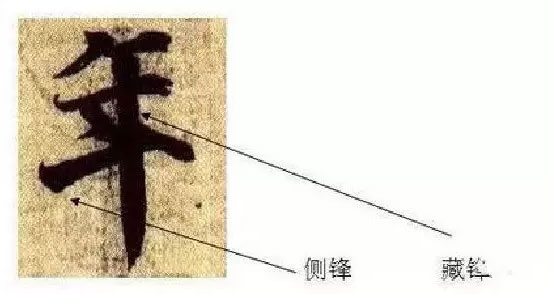
(二)侧笔。
侧笔者乏,亦不宜抽细而且紧。
侧锋乏力,但用中锋也不能太细。
侧锋用于起笔,中锋用于行笔:竖画横起,横画竖起:开始八笔都是删锋,转八行笔时必用中锋侧。
(三)押笔
押笔者入,从腹起而押之,又云利道而牵,押,即合也。
押笔是写下一笔之前的连带,从下一画的中部(大概)入笔,即押入:连带与下一笔的前半部重台:如无字二横与三横的连带,与三横的前部分重台;贤字又横的前押。
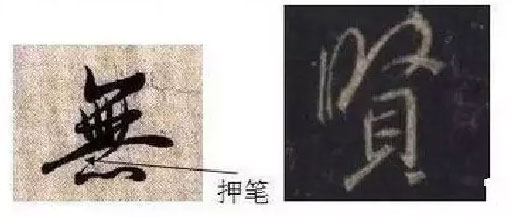
(四)结笔
结笔者撮,渐次相就必始然矣,参乎妙理,察其径趣。
结,有收束的意思。撮是聚合。把展开的笔毫收拢回来,笔锋如展笔以前一样尖挺:如竹字,右边一横。
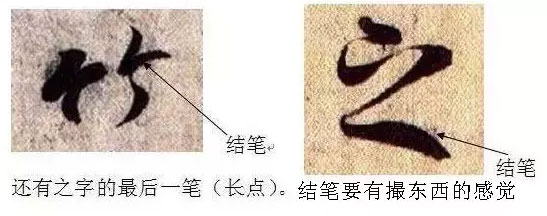
(五)憩笔
憩笔者侯失.憩笔之势,视其长短,侯失,右脚须欠也。
憩,有休电的意思。俟,有大的意巴。意为写字时右下角的笔画象有大的缺失。缺失多少视笔画长短而定。
关于憩笔,看一下憩流的解释:在海峡,水道,河口或狭窄的港湾内,当涨落潮流交替时,出现短时间近乎停止流动
的状态,称为憩流。
若用水流比作行笔,憩笔就是突然停止行笔的意思。
为什么要这种憩笔的笔法呢?笔者试着解析一下:
前面引用过黄帝内经的一句话天不足西北,地不满东南。
字的右下角在圉纸方位上属于西北,那这个憩笔就是休现天,不足西北的意巴:如是字的撩.矣字的点,作字的末横。
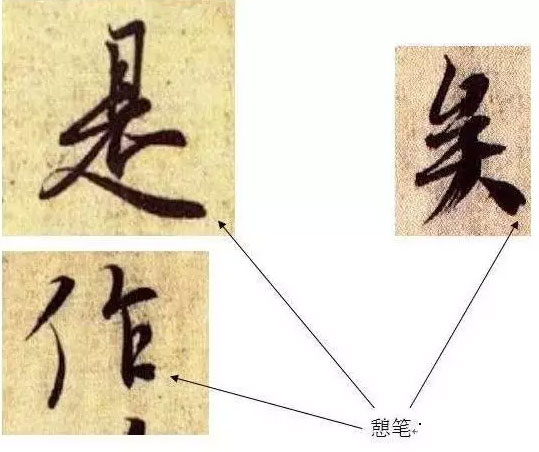
那地不满东南又如何解释呢?我们经常看到古人字帖里上面的口字旁的左上角写成开口,左上角属于东南:这是表示
地不满东南的意思。
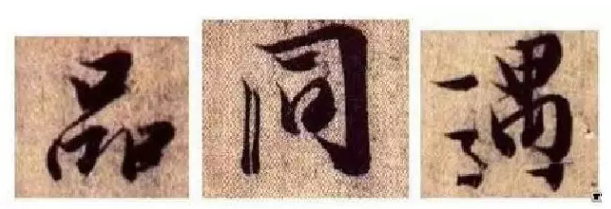
由此可见,把天地之理蕴于书痃之中者非王羲之而不能。
(6) Interest pen
The person who stops writing is forced to drive away, and the trend of stopping is upward, which is long and tight.
Xi has the meaning of rest and stop: it means that at the end of the stroke, you must first pause the stroke, and then quickly lift it upward: such as the last horizontal stroke of left and to.
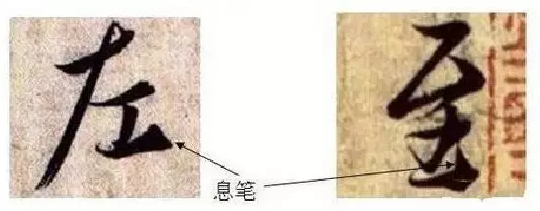
(7) frowning
When the writer is frowning, he is raising his eyebrows, and when he is about to draw the line, it is said that all his faults are exhausted. He writes slowly to get what he wants, and it should not be long or short.
"Wrinkle" has the meaning of shortness, and will also mean maintenance: it means that the corner should be written in a short time, do not try your best to write it all, and write slowly when writing the corner.
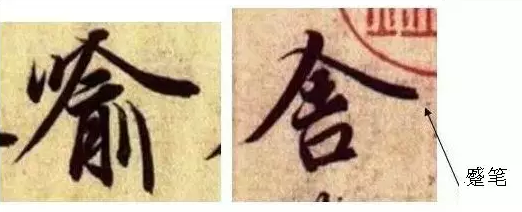
Wang Xizhi almost always writes the characters prefixed with human characters with a frown.
(8) War pen
The author of Zhan means He, Zhan, Zhen, He, Ye, and Sui should not be long or short.
Zhanbi means trembling strokes, like a long snake formation, which are coordinated with other strokes: the strokes are done slowly, not too long or too short. For example, the left vertical character of "Quhe" is vertical, and the right vertical character of "Song" characters is vertical.
(9) stable pen
The author or the machine may cause the injury to increase. Jue, the one who calls it beautiful: seeing the situation as an opportunity is the most wonderful thing about making things happen.
The stable brush has the meaning of reverse stroke, and the brush is drawn upward quickly and not too long: using the stable brush means that the painting is beautiful. Making it the most crucial stroke of this painting. If and the word abbreviation
The last stroke of "Yang" is the last stroke of "Yangzi Youjian".
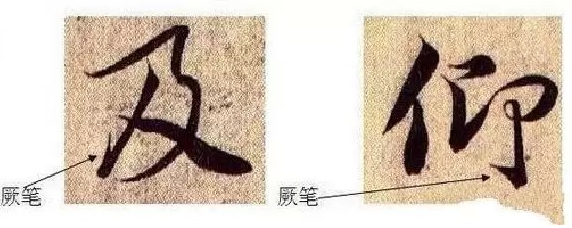
(10) Bring a pen
Bring the pen to the end, do not take credit for fine strokes, the belt is turned around and walked in to dress the body, the words are fresh and clean, and the momentum of writing has its weight. He wrote it all and drew it out again and again.
With the pen is the connection of strokes. For example, the character "矣" with one horizontal line and two horizontal lines are connected together.
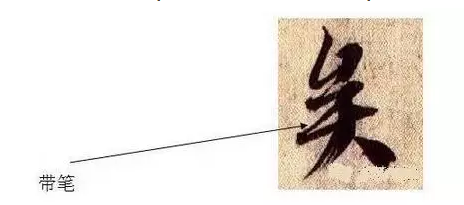
(11) Turn over the pen
The author Xianran said that the gesture of turning the pen is urgent and fast, and it is not suitable for those with long waist and short neck.
Fanbi is used in front, urgent and fast, and cannot be written with long waist and short items. The two vertical heads of the word "Lin" are used to turn the pen.
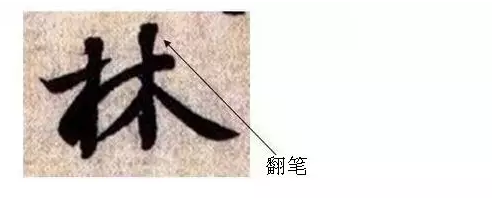
(12) Stacked pens
The time when the writer is stacked is bad, and the slowness should not be long.
When the strokes are stacked, they cannot be written in a strong manner. Instead, they should be written in a slow and thin manner, and the strokes should not be too long. It means to accumulate weakness or strength. For example, the character long has three horizontal lines and the character set has four horizontal lines.
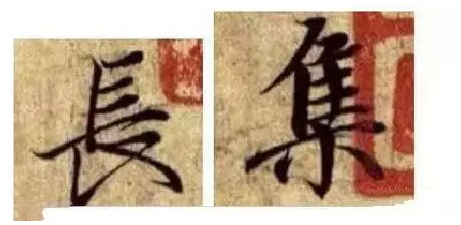
(13) Start writing
When raising the pen, do not lower it. Lift it in the abdomen, do not expose the pen, and take the momentum from start to stop so as not to lose control.
The strokes should be started from different downward strokes, starting from the middle of the stroke and moving up. Do not expose the tip of the stroke, and consider the structure of the beginning and end. Such as the two short horizontal lines of the word "tuo".
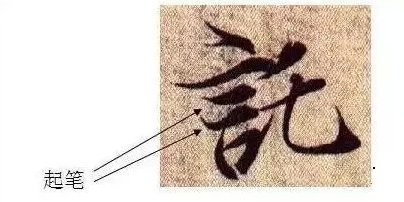
(14) Writing
The author thinks of broadness, but narrows the scope of the matter. Broadness means fast and healthy, but it is not advisable to make repairs later.
When writing, start writing quickly and perpendicular to the direction of the stroke, and then make the stroke slightly thinner. Don't be slow and don't make repairs. Such as the vertical head of Shaozi, the middle vertical head of Changzi Shen
